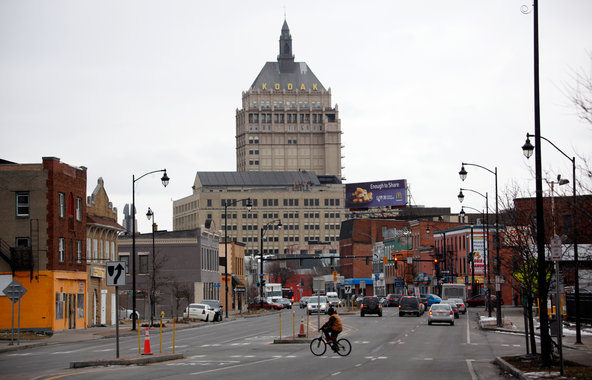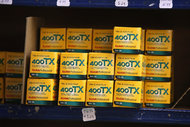 David Duprey/Associated PressEastman Kodak’s headquarters in Rochester.
David Duprey/Associated PressEastman Kodak’s headquarters in Rochester.
When Eastman Kodak emerges from bankruptcy this summer or fall, it will be a shadow of the blue-chip corporate giant it once was.
A celebrated company whose little yellow packages of film documented generations of birthday parties, weddings and anniversaries, the new Kodak will be more commercially focused, providing printing and imaging services to businesses as well as film to the movie industry.
Consumers will probably still be able to find Kodak-brand film in vacation spots around the world. They will still be able to buy digital cameras bearing the Kodak name. And they will still be able to download and print their digital pictures at kiosks in their local drugstores.
But those businesses will no longer be owned or controlled by Kodak. As part of the more than yearlong bankruptcy process, they were sold to others.
Antonio M. Perez, Kodak’s oft-criticized chief executive, who has been trying to stage a turnaround of the company since 2005 and has overseen it through bankruptcy proceedings, said in a news release this week that the company had a “clear path forward” and was positioned for a “profitable and sustainable future.”
 Yuri Gripas/ReutersKodak’s chief, Antonio Perez.
Yuri Gripas/ReutersKodak’s chief, Antonio Perez.
But some skeptics sounded warnings about Kodak’s outlook, noting that certain commercial businesses that the company is banking on are fiercely competitive and that Kodak’s own projections show steep declines in growth in other business lines.
The steady decline and evolution of Kodak’s business has been felt most strongly in Rochester, where the predecessor for the company was founded by George Eastman in 1881.
A classic, all-American company town whose landscape is dotted with the legacy of Mr. Eastman and Kodak, Rochester and some of its residents admit that the days of Kodak as a corporate giant were well behind it.
“I cannot remember a case that I’ve ever been associated with in any way where so many people wanted the company to succeed but so few people thought it actually could,” said John C. Ninfo II, a retired United States bankruptcy judge whose grandfather worked at Kodak and whose great uncle tended the gardens at the Eastman house. “For some, the bankruptcy proceeding has been a sorrowful thing, like losing a family member.”
But critics of the company also said its unwillingness — seemingly even in the throes of bankruptcy — to acknowledge that many of its products had fallen out of favor and become almost quaint in an increasingly digitized world was its ultimate downfall.
“The company made a big mistake of riding the cash cow — film — to the point that there was simply no more milk coming from it,” said George T. Conboy, the chairman of Brighton Securities, a stock brokerage and financial services firm in Rochester.
In the bankruptcy process over the last year, many of Kodak’s most recognizable businesses were either transferred or sold.
Early last year, it announced plans to stop making digital cameras, pocket video cameras and digital picture frames. Kodak recently entered an agreement to license its name for digital cameras to another company. It sold part of its online photo publishing service to the Internet publishing firm Shutterfly for $23.8 million.
But the bankruptcy process hit a major snag last year when the company struggled to sell what it considered to be a crown jewel — a package of 1,100 digital imaging patents.
Kodak had hoped the patents could go for as much as $2.6 billion. But a consortium of buyers that included some of the world’s largest technology companies, like Apple, Google and Facebook, bought the patents in December for far less, about $527 million. The firms have not said how they plan to incorporate or use the Kodak technology, and many of the patents are for processes and methods that consumers often cannot see. That money was used to repay a big chunk of a loan that Kodak had obtained shortly after filing for bankruptcy in early 2012.
“What that situation signified — which was part of the problem with the whole business model — is that they thought their technology and their patents were more valuable than they really were,” said Jay T. Westbrook, a professor at the University of Texas Law School. “They clung to that right until the end.”
Another big hurdle in the bankruptcy proceedings was cleared this week when Kodak said it would spin off two businesses to the Kodak Pension Plan in Britain for $650 million in cash and debt as part of a deal that would absolve Kodak of $2.8 billion of claims the pension had made against the company. The agreement still needs the approval of the bankruptcy court.
 Scott Olson/Getty ImagesKodak’s pension plan in Britain recently bought the rights to two operating units, including the one that produces Kodak-brand film.
Scott Olson/Getty ImagesKodak’s pension plan in Britain recently bought the rights to two operating units, including the one that produces Kodak-brand film.
The two segments that were sold include document imaging and the business that made Kodak a household name, its camera film and photographic paper lines, along with the kiosks found in Target and Walgreens stores where consumers can download and print pictures.
Officials with the British pension fund, which retained the right to use the Kodak brand, have indicated that they intend to hire a management team to run the business. A spokesman for Steven Ross, chairman of the fund, could not reach Mr. Ross for a requested interview.
The film business is in a decline, but observers said the deal was probably the best alternative for the pension fund.
“They can either run the business and throw off cash every year to pay the pensioners,” Professor Westbrook said. “Or they can keep the business for a year or two or five years and maybe something will happen that will make it look better and sell it then.”
As for Kodak’s new focus on the commercial side of the business, analysts worry that future growth and profits could prove difficult there as well.
For instance, in a presentation Kodak provided this year to its creditors in the bankruptcy court, Kodak showed a sharp 34 percent decline in growth through 2017 in the segment that includes the entertainment imaging and commercial films business.
Another business Kodak is banking on for its future is its commercial printing and packaging business, which creates packaging labels for companies, like the plastic labels found on a bottle of juice. Analysts describe that as a highly fragmented and competitive industry and say that Kodak’s share of the market is fairly small.
In an e-mailed response to questions, a Kodak spokesman said that the company “has a compelling and unique combination of advantages to lead this industry.”
But some observers see an uphill battle.
“This is a company that is going from being a behemoth that owned the market to a niche player scrapping for share,” Mr. Conboy said. “It will be a different game for the new Eastman Kodak.”
Article source: http://dealbook.nytimes.com/2013/05/03/after-bankruptcy-a-leaner-kodak-faces-an-uphill-battle/?partner=rss&emc=rss